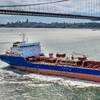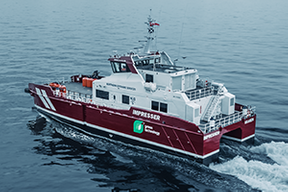Northrop Grumman Q3 2009 Results
Northrop Grumman Corporation (NYSE: NOC) reported that second quarter 2009 earnings from continuing operations totaled $394 million, or $1.21 per diluted share, compared with $483 million, or $1.40 per diluted share, in the second quarter of 2008. Second quarter 2009 net pension adjustment (FAS/CAS) reduced earnings from continuing operations by $49 million, or $0.15 per diluted share, compared with an increase to earnings from continuing operations of $45 million, or $0.13 per diluted share, in the second quarter of 2008.
Second quarter 2009 earnings included a net $64 million pre-tax gain, or $0.13 per diluted share, for legal matters, as well as a $105 million pre-tax charge, or $0.21 per diluted share, for cost increases in the estimates to complete several ships under construction at the company's Gulf Coast shipyards.
Sales for the 2009 second quarter increased 4 percent to $8.96 billion from $8.63 billion in the 2008 second quarter. Second quarter 2009 sales were reduced by $100 million due to the estimate to complete adjustments in Shipbuilding. In the 2009 second quarter, $830 million of cash was provided by operations, compared with $607 million of cash provided by operations in the prior year period.
"Overall, our portfolio continues to perform well. This quarter's financial results reflect higher pension costs and the aggressive actions we are taking to drive improvement in our Gulf Coast shipbuilding programs. Our year-to-date performance is on-track and we are confirming our 2009 guidance for sales, EPS and cash generation," said Ronald D. Sugar, chairman and chief executive officer.
Operating income for the 2009 second quarter totaled $653 million compared with $806 million in the prior year period. The change reflects a $145 million increase in net pension expense and a $112 million decrease in Shipbuilding operating income, which were partially offset by a $64 million improvement in unallocated expenses principally due to the settlement of certain legal matters. As a percent of sales, operating income declined to 7.3 percent from 9.3 percent in the prior year period.
Pension-adjusted operating income totaled 8.1 percent of sales for the second quarter 2009 compared with 8.5 percent of sales for the second quarter 2008. Second quarter 2009 pension-adjusted earnings per share from continuing operations increased 7 percent to $1.36 from $1.27 for the prior year period.
Federal and foreign income taxes for the 2009 second quarter declined to $202 million from $256 million in the second quarter of 2008. The effective tax rate applied to earnings from continuing operations for the 2009 second quarter was 33.9 percent compared with 34.6 percent in the 2008 second quarter.
Earnings per share are based on weighted average diluted shares outstanding of 325.8 million for the second quarter of 2009 and 344.1 million for the second quarter of 2008. During the second quarter of 2009 the company repurchased approximately 5.8 million shares of its common stock.
New business awards totaled $7.5 billion in the second quarter 2009. Total backlog, which includes funded backlog and firm orders for which funding is not currently contractually obligated by the customer, was $70.4 billion as of June 30, 2009, compared with $76.9 billion at March 31, 2009. During the second quarter the U.S. government terminated for convenience the Kinetic Energy Interceptor program. As a result of the termination, total backlog was reduced by $5.1 billion.
Cash provided by operations in the 2009 second quarter totaled $830 million compared with $607 million in the prior year period. The improvement is due to lower working capital than in the prior year period. Second quarter 2009 free cash flow totaled $676 million compared with free cash flow of $431 million in the prior year period.
As previously reported, on April 2 the company reached an agreement with the U.S. government to settle two legal matters: the Department of Justice's microelectronics claim and the company's claim against the U.S. government related to the award, performance and termination of the Tri-Service Standoff Attack Missile (TSSAM) program. While the stated settlement amounts for the two claims were equal and therefore offset each other, the company had previously recorded a provision for the microelectronics claim. After legal costs and provisions for litigation matters, the company recorded a net pre-tax gain of $64 million in the 2009 second quarter.
Beginning in the first quarter of 2009, operating results for all periods presented reflect the realignment of the former Mission Systems and Information Technology sectors into Information Systems and the realignment of the former Integrated Systems and Space Technology sectors into Aerospace Systems. In addition, the presentation reflects the transfer of certain businesses from Information Systems and Electronic Systems to Technical Services. Schedule 6 provides previously reported quarterly financial results revised to reflect the current reporting structure.
Shipbuilding second quarter 2009 sales decreased 10 percent primarily due to lower volume for expeditionary warfare programs than in the prior year period. These declines were partially offset by higher volume for submarine programs. Lower expeditionary warfare volume was principally due to a $100 million revenue reduction related to the revised estimates to complete LPD-class ships and the LHA 6. Lower expeditionary warfare volume also reflects the delivery of the LHD 8.
Shipbuilding operating income for the 2009 second quarter declined to $14 million from $126 million in the second quarter of 2008. Second quarter 2009 operating income includes a $105 million pre-tax charge to reflect higher estimates to complete LPD-class ships and the LHA 6. These adjustments reflect additional expense to improve design, engineering, production and quality processes. The adjustments for the LPD class primarily reflect increased production cost estimates. The LHA 6 adjustment reflects increased investment to mature the ship's engineering and design work and reduce future production risk.













